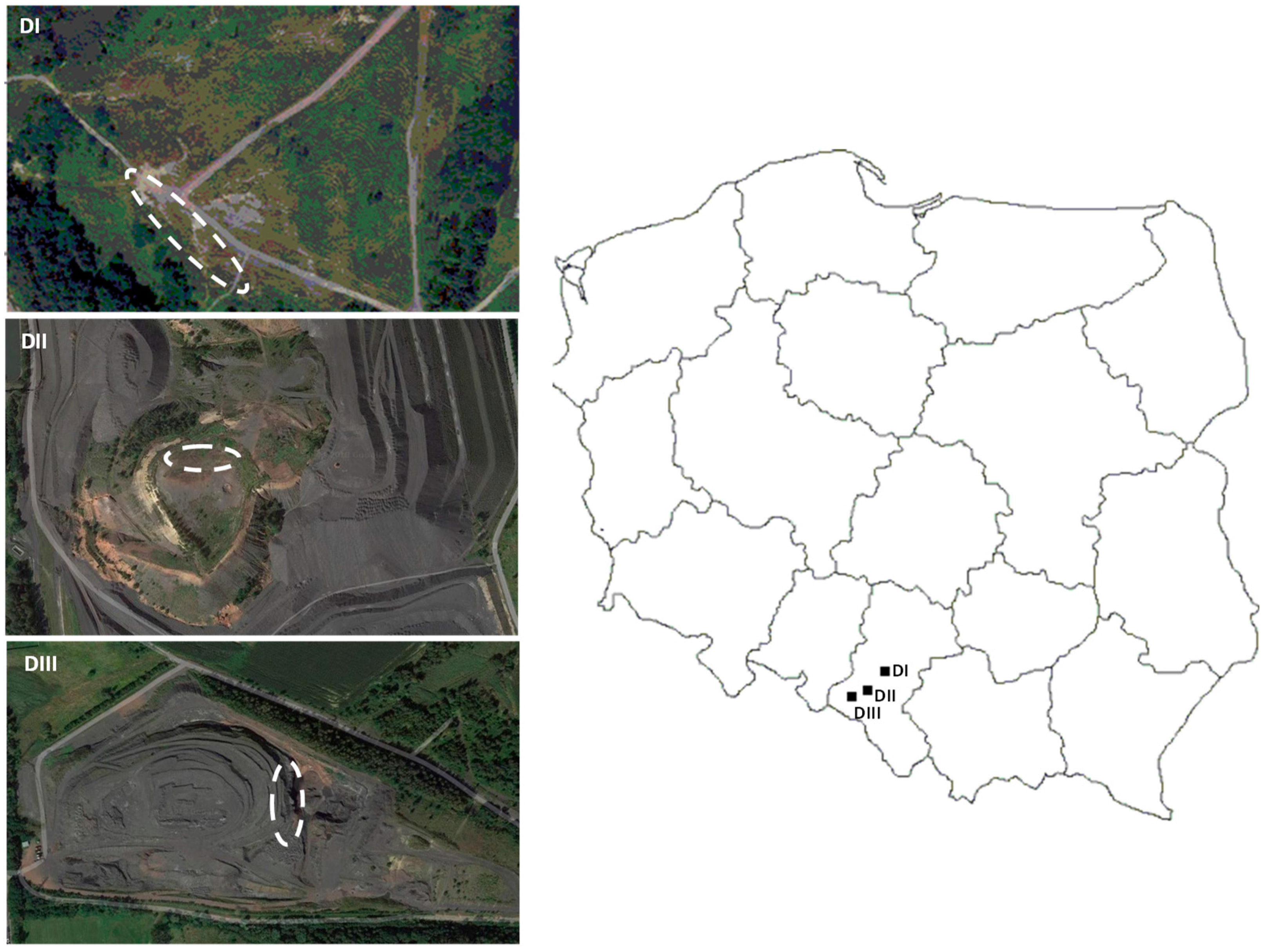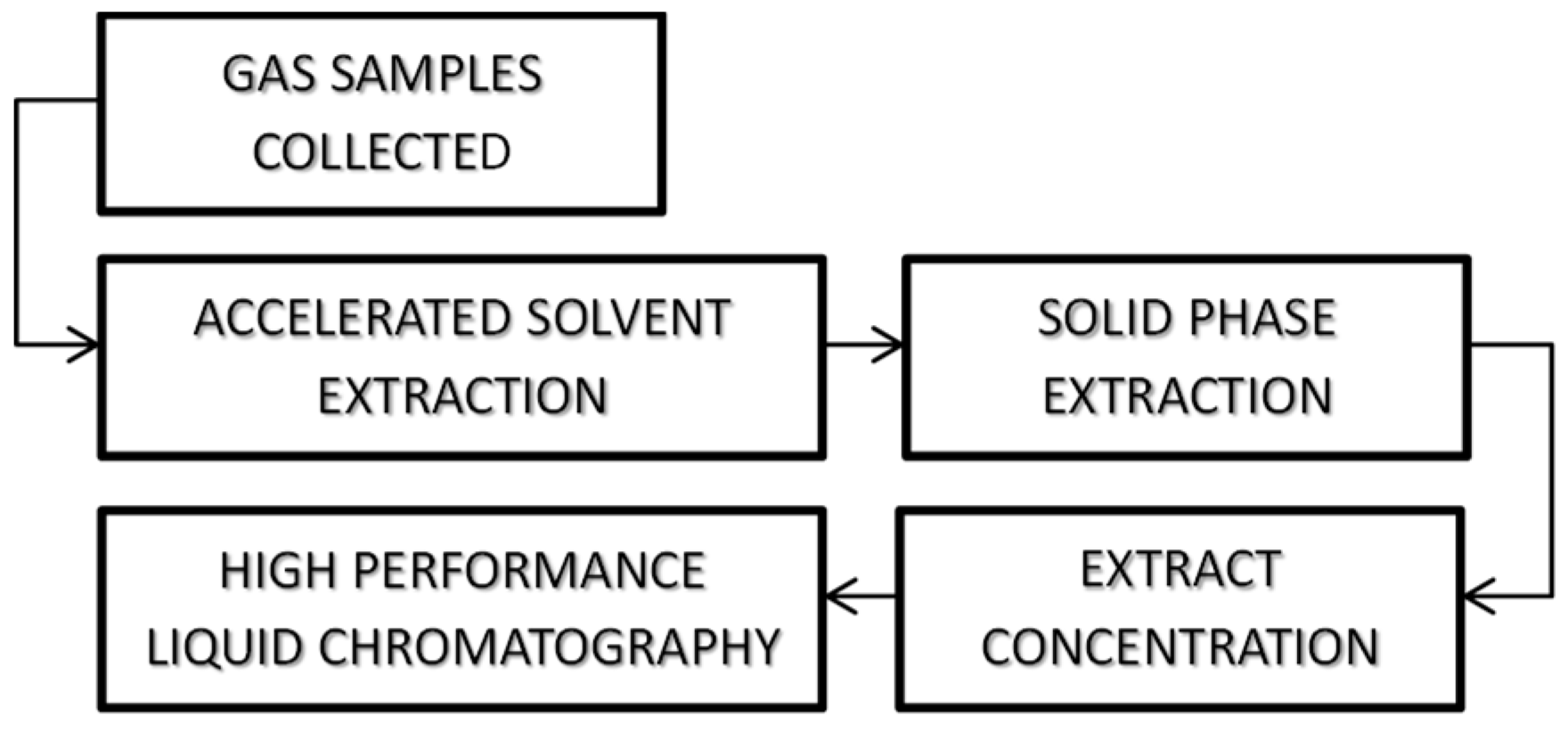Assessment of Emission of Selected Gaseous Components from Coal Processing Waste Storage Site
Abstract
1. Introduction
2. Materials and Methods
2.1. Materials
2.2. Gas Sampling and Analytics
2.3. Experimental Data Exploration
3. Results and Discussion
- -
- cluster A, including all gas samples collected from the mine waste dump DIII (objects 49–72),
- -
- cluster B, including 12 gas samples collected from the mine waste dump DI (objects 1–12) and 16 samples collected from the dump DII (objects 25–27, 29–40 and 42),
- -
- cluster C, including the remaining 8 gas samples collected from the mine waste dump DII (objects 28, 41, 43–48), and
- -
- cluster D, including the remaining gas samples collected from the mine waste dump DI (objects 13–24).
- -
- subgroup B1, including objects 1–6,
- -
- subgroup B2, including objects 25–27, 29–37 and 42, and
- -
- subgroup B3, including objects 7–12 and 38–40.
- -
- subgroup D1, including objects 13–19 and 24, and
- -
- subgroup D2, including objects 20–23.
4. Conclusions
Acknowledgments
Author Contributions
Conflicts of Interest
References
- Góralczyk, S.; Baic, I. Odpady z górnictwa węgla kamiennego i możliwości ich gospodarczego wykorzystania. Polityka Energetyczna Energy Policy J. 2009, 12, 145–157. [Google Scholar]
- Chen, X.D. The effect of drying heat and moisture content on the maximum temperature rise during spontaneous heating of a moist coal pile. Coal Perparation 1994, 14, 223–236. [Google Scholar] [CrossRef]
- Falcon, R.M. Spontaneous combustion of the organic matter in discards from the Witbank coalfield. J. South. Afr. Inst. Min. Metall. 1986, 86, 243–250. [Google Scholar]
- Kuna-Gwoździewicz, P. Emission of polycyclic aromatic hydrocarbons from the exhalation zones of thermally active mine waste dumps. J. Sustain. Min. 2013, 12, 7–12. [Google Scholar] [CrossRef][Green Version]
- Howsam, M.; Jones, K.C. Sources of PAHs in the environment. In Part 1. PAHs and Related Compounds. The Handbook of Environmental Chemistry; Neilson, A.H., Ed.; Springer-Verlag: Berlin/Heidelberg, Germany, 1998; Volume 3, pp. 139–141. [Google Scholar]
- Bostrom, C.E.; Gerde, P.; Hanberg, A.; Jemstrom, B.; Johansson, C.; Kyrklund, T.; Rannug, A.; Törnqvist, M.; Victorin, K.; Westerholm, R. Cancer risk assessment, indicators, and guidelines for polycyclic aromatic hydrocarbons in the ambient air. Environ. Health Perspect. 2002, 110, 451–488. [Google Scholar] [CrossRef] [PubMed]
- U.S. Environmental Protection Agency. Determination of Polycyclic Aromatic Hydrocarbons (PAHs) in Ambient Air Using Gas Chromatography/Mass Spectrometry (GC/MS). Compendium of Methods for the Determination of Toxic Organic Compounds in Ambient Air; Center for Environmental Research Information, Office of Research and Development, U.S. Environmental Protection Agency: Cincinnati, OH, USA, 1999.
- Liu, C.; Li, S.; Qiao, Q.; Wang, J.; Pan, Z. Management of Spontaneous combustion in coal mine waste tips in China. Water Air Soil Pollut. 1997, 103, 441–444. [Google Scholar] [CrossRef]
- Sułkowski, J.; Drenda, J.; Różański, Z.; Wrona, P. Noticed in mining areas, environmental hazard connected with outflow of gases from abandoned mines and with spontaneous ignition of coal waste dumps. Gospod. Surowcami Miner. 2008, 24, 319–333. [Google Scholar]
- Pan, R.K.; Yu, M.G.; Lu, L.X. Experimental study on explosive mechanism of spontaneous combustion gangue dump. J. Coal Sci. Eng. 2009, 15, 394–398. [Google Scholar] [CrossRef]
- Tripathy, D.P.; Pal, B.K. Spontaneous heating susceptibility of coals—Evaluation based on experimental techniques. J. Mines Met. Fuels 2001, 49, 236–243. [Google Scholar]
- Singh, R.V.K.; Sharma, A.; Jhanwar, J.C. Different techniques for study of spontaneous heating susceptibility of coal with special reference to Indian coals. J. Mines Met. Fuels 1993, 41, 60–64. [Google Scholar]
- Vandeginste, B.G.M.; Massart, D.L.; Buydens, L.M.C.; De Jong, S.; Lewi, P.J.; Smeyers-Verbeke, J. Handbook of Chemometrics and Qualimetrics: Part B; Elsevier: Amsterdam, The Netherlands, 1998. [Google Scholar]
- Massart, D.L.; Kaufman, L. The Interpretation of Analytical Data by the Use of Cluster Analysis; John Wiley & Sons: New York, NY, USA, 1983. [Google Scholar]
- Vogt, W.; Nagel, D.; Sator, H. Cluster Analysis in Clinical Chemistry; A Model; John Wiley & Sons: New York, NY, USA, 1987. [Google Scholar]
- Smoliński, A. Gas chromatography as a tool for determining coal chars reactivity in the process of steam gasification. Acta Chromatogr. 2000, 20, 349–365. [Google Scholar] [CrossRef]
- Smoliński, A.; Howaniec, N. Co-gasification of coal/sewage sludge blends to hydrogen-rich gas with the application of simulated high temperature reactor excess heat. Int. J. Hydrogen Energy 2016, 41, 8154–8158. [Google Scholar] [CrossRef]
- Howaniec, N.; Smoliński, A.; Cempa-Balewicz, M. Experimental study on application of high temperature reactor excess heat in the process of coal and biomass co-gasification to hydrogen-rich gas. Energy 2015, 84, 455–461. [Google Scholar] [CrossRef]
- Smoliński, A.; Stańczyk, K.; Kapusta, K.; Howaniec, N. Analysis of the organic contaminants in the condensate produced in the in situ underground coal gasification process. Water Sci. Technol. 2013, 67, 644–650. [Google Scholar] [CrossRef] [PubMed]
- Petryl, T.; Schmidz, P.; Schlatter, C. The use of toxic equivalency factors in assessing occupational and environmental health risk associated with exposure to airborne mixtures of polycyclic aromatic hydrocarbons (PAHs). Chemosphere 1996, 32, 639–648. [Google Scholar] [CrossRef]
- Smoliński, A.; Walczak, B.; Einax, J.W. Hierarchical clustering extended with visual complements of environmental data set. Chemom. Intell. Lab. Syst. 2002, 64, 45–54. [Google Scholar] [CrossRef]



| No | Compound | Carcinogenicity 1 | Number of Rings | Average Concentration µg m−3 | ||
|---|---|---|---|---|---|---|
| DI | DII | DIII | ||||
| 1 | Naphthalene (NAP) | 0.001 | 2 | 534.43 | 991.06 | 83.21 |
| 2 | Acenaphthene (AcP) | 0.001 | 3 | 2.14 | 8.38 | 29.28 |
| 3 | Fluorene (Flu) | 0.001 | 3 | 14.50 | 12.33 | 0.89 |
| 4 | Phenanthrene (PA) | 0.001 | 3 | 24.10 | 12.89 | 2.62 |
| 5 | Anthracene (Ant) | 0.010 | 3 | 4.05 | 0.40 | 0.19 |
| 6 | Fluoranthene (FluT) | 0.001 | 4 | 0.55 | BDL | 1.72 |
| 7 | Pyrene (Pyr) | 0.001 | 4 | 0.30 | BDL | 0.14 |
| 8 | Benzo(a)anthracene (BaA) | 0.001 | 4 | 0.16 | BDL | 0.02 |
| 9 | Chrysene (Chr) | 0.001 | 4 | 0.22 | BDL | BDL |
© 2018 by the authors. Licensee MDPI, Basel, Switzerland. This article is an open access article distributed under the terms and conditions of the Creative Commons Attribution (CC BY) license (http://creativecommons.org/licenses/by/4.0/).
Share and Cite
Howaniec, N.; Kuna-Gwoździewicz, P.; Smoliński, A. Assessment of Emission of Selected Gaseous Components from Coal Processing Waste Storage Site. Sustainability 2018, 10, 744. https://doi.org/10.3390/su10030744
Howaniec N, Kuna-Gwoździewicz P, Smoliński A. Assessment of Emission of Selected Gaseous Components from Coal Processing Waste Storage Site. Sustainability. 2018; 10(3):744. https://doi.org/10.3390/su10030744
Chicago/Turabian StyleHowaniec, Natalia, Patrycja Kuna-Gwoździewicz, and Adam Smoliński. 2018. "Assessment of Emission of Selected Gaseous Components from Coal Processing Waste Storage Site" Sustainability 10, no. 3: 744. https://doi.org/10.3390/su10030744
APA StyleHowaniec, N., Kuna-Gwoździewicz, P., & Smoliński, A. (2018). Assessment of Emission of Selected Gaseous Components from Coal Processing Waste Storage Site. Sustainability, 10(3), 744. https://doi.org/10.3390/su10030744






